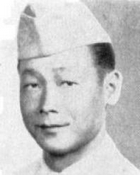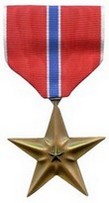Mushie Miyagi
| Date and Place of Birth: | September 24, 1915 Aiea, Oahu, Hawaiian Islands |
| Date and Place of Death: | November 5, 1943 Venafro, Italy |
| Baseball Experience: | Amateur |
| Position: | Second Base |
| Rank: | Sergeant |
| Military Unit: | Company E, 100th Battalion US Army |
| Area Served: | Mediterranean Theater of Operations |
Mushie Miyagi was a second-generation Japanese who willingly fought for America and died on the battlefields of Italy.
Masayoshi "Mushie" Miyagi was born at Aiea, Oahu in the Hawaiian
Islands on September 24, 1915. Like many people in Hawaii, he was Nisei
- second-generation Japanese. He attended McKinley High School where he
starred on the school baseball team and went on to play in the Hawaiian
amateur leagues.
Miyagi entered military service on December 10, 1940 and served at
Schofield Barracks, Oahu. One year later Pearl Harbor was attacked by
the Japanese and while most Japanese-Americans were sent to internment
camps, the Japanese-Americans of the Hawaiian Territorial Guard became
the 100th Infantry Battalion - a fighting unit made up entirely of
second-generation Japanese.
Miyagi married Kimiko Takahashi of Hilo on June 1, 1942 before heading
to the mainland for basic training with the 100th at Camp McCoy,
Wisconsin. The young second baseman quickly became a part of the 100th
"Aloha" baseball team which initially played against the military police
unit at Camp McCoy but soon found competition in nearby towns. In a
memorable game against a minor league team in Green Bay, Wisconsin,
Miyagi was part of an outstanding defensive play. "An opposing batter
hit a towering drive over our rightfielder's head," remembers "Aloha"
team manager Takashi "Ted" Hirayama remembers. "After the outfielder
retrieved the ball, he threw it to Joe Takata, who was playing center.
Joe relayed it on a line to Mushie Miyagi, our second baseman, who then
turned and threw the ball on one skip to the catcher, who tagged the
surprised runner out. I still remember the announcer saying that it
would take a major league team to make a play like that, and these
little guys from Hawaii just did it. They play like pros."
In February 1943, the 100th Battalion moved to Camp Shelby, Mississippi
for advanced unit training where the Aloha team continued to play.
The 100th Battalion left Camp Shelby for North Africa on August 11,
1943. They landed at Oran, Algeria on September 2, where they guarded
supply trains for a couple of weeks. It was in North Africa that the
Aloha baseball team played their last game. Challenged by the 133rd
Infantry Regiment, the 100th called upon Lieutenant Paul E. Froning, who
had just joined them. Froning would pitch in the minors after the war
and helped defeat the 133rd, 26 to 0.
On September 19, 1943, the 100th Battalion left the relative safety of
North Africa for Italy. They landed at Salerno and went into combat
against the Germans on September 29.
Sergeant Miyagi was killed in action near Venafro, Italy on November 5,
1943. He was awarded the Bronze Star and Purple Heart and is buried at
the National Memorial Cemetery of the Pacific in Hawaii.
Thanks to Kerry Yo Nakagawa of the Nisei Baseball Research Project and Hawaii State Library for help with this biography. Photo of 100th Battalion team courtesy of Sons and Daughters of the 100th Infantry Battalion Archives.
Date Added: February 7, 2013
Baseball's Greatest Sacrifice is associated with Baseball Almanac
Baseball's Greatest Sacrifice is proud to be sponsored by



